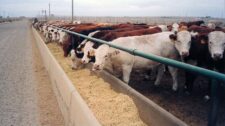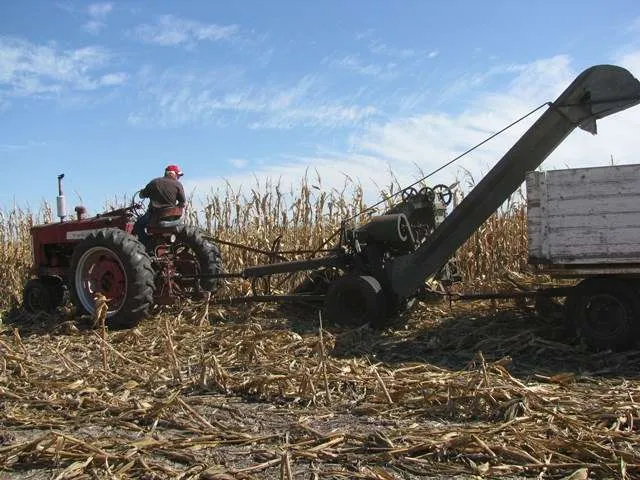ISSN: 1948-9080
Released September 19, 2014, by the National Agricultural Statistics Service
(NASS), Agricultural Statistics Board, United States Department of
Agriculture (USDA).
United States Cattle on Feed Down 1 Percent
Cattle and calves on feed for slaughter market in the United States for
feedlots with capacity of 1,000 or more head totaled 9.8 million head on
September 1, 2014. The inventory was 1 percent below September 1, 2013.
Placements in feedlots during August totaled 1.72 million, 3 percent below
2013. Net placements were 1.65 million head. During August, placements of
cattle and calves weighing less than 600 pounds were 410,000, 600-699 pounds
were 280,000, 700-799 pounds were 395,000, and 800 pounds and greater were
635,000. For the month of August placements are the lowest since the series
began in 1996.
Marketings of fed cattle during August totaled 1.69 million, 10 percent
below 2013. August marketings are the lowest since the series began in 1996.
Other disappearance totaled 66,000 during August, 32 percent above 2013.
Number of Cattle on Feed, Placements, Marketings, and Other Disappearance on
1,000+ Capacity Feedlots – United States: September 1, 2013 and 2014
——————————
——-
: Number :
Percent of
Item :—————————:
: 2013 : 2014
:previous year
——————————
——-
: —- 1,000 head —-
percent
:
On feed August 1 …………………..: 10,025 9,837
98
Placed on feed during August ………..: 1,772 1,720
97
Fed cattle marketed during August ……: 1,871 1,692
90
Other disappearance during August ……: 50 66
132
On feed September 1 ………………..: 9,876 9,799
99
——————————
——-
Number of Cattle on Feed, Placements, Marketings, and Other Disappearance on
1,000+ Capacity Feedlots – United States: August 1, 2013 and 2014
——————————
——-
: Number :
Percent of
Item :—————————:
: 2013 : 2014
:previous year
——————————
——-
: —- 1,000 head —-
percent
:
On feed July 1 …………………….: 10,375 10,127
98
Placed on feed during July ………….: 1,684 1,560
93
Fed cattle marketed during July ……..: 1,970 1,787
91
Other disappearance during July ……..: 64 63
98
On feed August 1 …………………..: 10,025 9,837
98
——————————
——-
Number of Cattle on Feed on 1,000+ Capacity Feedlots by Month – States and
United States:
2013 and 2014
——————————
———————–
: : :
September 1, 2014
: :
:—————————–
State :September 1, 2013: August 1, 2014 : :
Percent of : Percent of
: : : Number
:previous year :previous month
——————————
———————–
: ————– 1,000 head ————-
—– percent —-
:
Arizona ……….: 266 262 257
97 98
California …….: 505 420 415
82 99
Colorado ………: 830 810 800
96 99
Idaho …………: 190 185 180
95 97
Iowa ………….: 550 600 580
105 97
Kansas ………..: 1,980 1,900 1,950
98 103
Minnesota ……..: 101 116 113
112 97
Nebraska ………: 2,090 2,160 2,130
102 99
Oklahoma ………: 280 240 245
88 102
South Dakota …..: 170 190 185
109 97
Texas …………: 2,430 2,470 2,450
101 99
Washington …….: 184 189 199
108 105
:
Other States …..: 300 295 295
98 100
:
United States ….: 9,876 9,837 9,799
99 100
——————————
———————–
Number of Cattle Placed on Feed on 1,000+ Capacity Feedlots by Month –
States and United States: 2013 and 2014
——————————
—————–
: : : During August
2014
: During : During
:—————————–
State : August 2013 : July 2014 : : Percent of
: Percent of
: : : Number :previous
year :previous month
——————————
—————–
: ———— 1,000 head ———– —–
percent —-
:
Arizona ……….: 23 23 21 91
91
California …….: 55 39 40 73
103
Colorado ………: 145 90 145 100
161
Idaho …………: 52 37 33 63
89
Iowa ………….: 66 56 63 95
113
Kansas ………..: 380 400 410 108
103
Minnesota ……..: 13 10 15 115
150
Nebraska ………: 440 375 425 97
113
Oklahoma ………: 47 32 50 106
156
South Dakota …..: 28 20 30 107
150
Texas …………: 440 410 410 93
100
Washington …….: 43 37 44 102
119
:
Other States …..: 40 31 34 85
110
:
United States ….: 1,772 1,560 1,720 97
110
——————————
—————–
Number of Cattle Placed on Feed by Weight Group on 1,000+ Capacity Feedlots
by Month – States and United States: 2013 and 2014
——————————
————
: During August
:—————————–
State :Under 600 lbs: 600-699 lbs : 700-799 lbs : 800+ lbs :
Total
:—————————–
: 2013 : 2014 : 2013 : 2014 : 2013 : 2014 : 2013 : 2014 :
2013 : 2014
——————————
————
: 1,000 head
:
Colorado ………: 25 30 20 15 45 35 55 65
145 145
Kansas ………..: 65 75 80 80 115 110 120 145
380 410
Nebraska ………: 55 55 65 50 100 95 220 225
440 425
Texas …………: 175 170 115 95 95 85 55 60
440 410
:
Other States …..: 85 80 47 40 70 70 165 140
367 330
:
United States ….: 405 410 327 280 425 395 615 635
1,772 1,720
:—————————–
: During July
:—————————–
State :Under 600 lbs: 600-699 lbs : 700-799 lbs : 800+ lbs :
Total
:—————————–
: 2013 : 2014 : 2013 : 2014 : 2013 : 2014 : 2013 : 2014 :
2013 : 2014
:—————————–
: 1,000 head
:
Colorado ………: 30 25 20 15 30 20 40 30
120 90
Kansas ………..: 60 80 75 70 140 110 150 140
425 400
Nebraska ………: 45 55 55 50 90 85 180 185
370 375
Texas …………: 165 185 75 85 125 85 85 55
450 410
:
Other States …..: 90 80 45 40 60 55 124 110
319 285
:
United States ….: 390 425 270 260 445 355 579 520
1,684 1,560
——————————
————
Number of Cattle Marketed on 1,000+ Capacity Feedlots by Month – States and
United States:
2013 and 2014
——————————
—————–
: : : During August
2014
: During : During
:—————————–
State : August 2013 : July 2014 : : Percent of
: Percent of
: : : Number :previous
year :previous month
——————————
—————–
: ———— 1,000 head ———– —–
percent —-
:
Arizona ……….: 18 26 25 139
96
California …….: 60 47 40 67
85
Colorado ………: 180 145 150 83
103
Idaho …………: 46 41 37 80
90
Iowa ………….: 73 74 80 110
108
Kansas ………..: 390 390 345 88
88
Minnesota ……..: 20 15 17 85
113
Nebraska ………: 420 465 440 105
95
Oklahoma ………: 51 46 44 86
96
South Dakota …..: 37 39 34 92
87
Texas …………: 490 415 415 85
100
Washington …….: 47 40 33 70
83
:
Other States …..: 39 44 32 82
73
:
United States ….: 1,871 1,787 1,692 90
95
——————————
—————–
Other Disappearance on 1,000+ Capacity Feedlots by Month – States and United
States:
2013 and 2014
——————————
—————–
: : : During August
2014
: During : During
:—————————–
State : August 2013 : July 2014 : : Percent of
: Percent of
: : : Number :previous
year :previous month
——————————
—————–
: ———- 1,000 head ———- —–
percent —-
:
Arizona ……….: 1 7 1 100
14
California …….: 5 7 5 100
71
Colorado ………: 5 5 5 100
100
Idaho …………: 1 1 1 100
100
Iowa ………….: 3 2 3 100
150
Kansas ………..: 10 10 15 150
150
Minnesota ……..: 1 1 1 100
100
Nebraska ………: 10 10 15 150
150
Oklahoma ………: 1 1 1 100
100
South Dakota …..: 1 1 1 100
100
Texas …………: 10 15 15 150
100
Washington …….: 1 1 1 100
100
:
Other States …..: 1 2 2 200
100
:
United States ….: 50 63 66 132
105
——————————
—————–
Terms and Definitions of Cattle on Feed Estimates
Cattle on feed are animals being fed a ration of grain, silage, hay and/or
protein supplement for slaughter market that are expected to produce a
carcass that will grade select or better. It excludes cattle being
“backgrounded only” for later sale as feeders or later placement in another
feedlot.
Placements are cattle put into a feedlot, fed a ration which will produce a
carcass that will grade select or better, and are intended for the slaughter
market.
Marketings are cattle shipped out of feedlots to a slaughter market.
Other disappearance includes death loss, movement from feedlots to pasture,
and shipments to other feedlots for further feeding.
Reliability of Cattle on Feed Estimates
Survey Procedures: During January and July all known feedlots in the United
States with capacity of 1,000 or more head are surveyed to provide data for
cattle on feed estimates. During the other months, all known feedlots from
16 States are surveyed. The 16 States account for approximately 98 percent
of the cattle on feed in feedlots with capacity of 1,000 or more head.
Individual State estimates are published monthly for 12 of the 16 States.
Data collected from the remaining 4 States are used to establish the “Other
States” estimates. These 4 States include Illinois, New Mexico, Oregon, and
Wyoming. The “Other States” category represents all cattle on feed with a
capacity of 1,000 or more head for the rest of the United States.
Estimating Procedures: These cattle on feed estimates were prepared by the
Agricultural Statistics Board after reviewing recommendations and analysis
submitted by each State office. Regional and State survey data were reviewed
for reasonableness with each other and with estimates from the previous
month when establishing the current estimates.
Revision Policy: Revisions to previous estimates are made to improve month
to month relationships. Estimates for the previous month are subject to
revision in all States each month when current estimates are made. In
February, all monthly estimates for the previous year, and the number of
feedlots and annual marketings from two years ago are reviewed and subject
to revisions.
The reviews are primarily based on slaughter data, state check-off or brand
data, and any other data that may have been received after the original
estimate was made. Estimates will also be reviewed after data from the
Census of Agriculture are available. No revisions will be made after that
date and estimates become final.
Reliability: Since all 1,000+ capacity cattle on feed operators in every
State are not included in the monthly survey, survey estimates are subject
to sampling variability. Survey results are also subject to non-sampling
errors such as omissions, duplications, and mistakes in reporting,
recording, and processing the data. The effects of these errors cannot be
measured directly.
They are minimized through rigid quality controls in the data collection
process and through a careful review of all reported data for consistency
and reasonableness.
To assist users in evaluating the reliability of estimates in this report,
the “Root Mean Square Error” is shown for selected items in the table on the
following page. The “Root Mean Square Error” is a statistical measure based
on past performance and is computed using the differences between first and
latest estimates. The “Root Mean Square Error” for cattle on feed inventory
estimates over the past 24 months is 0.1 percent. This means that chances
are
2 out of 3 that the final estimate will not be above or below the current
estimate of 9.8 million head by more than 0.1 percent. Chances are 9 out of
10 that the difference will not exceed 0.2 percent.
The table on the following page shows a 24 month record of the range of
differences between first and latest estimates for selected items. Using
estimates of number on feed as an example, changes between the first
estimate and the latest estimate during the past 24 months have averaged
9,000 head, ranging from 0 to 34,000 head. During this period the initial
estimate has been above the latest estimate 8 times and has been below the
latest estimate
9 times. This does not imply that the initial estimate is likely to
understate or overstate final inventory.
Reliability of Monthly Cattle on Feed Estimates [Based on data for the past
24 months]
——————————
——————————
: Root mean : 90 percent :
Difference between first and latest estimate
: square error : confidence : :
: : :
: : level
:—————————–
Item : : : :
: : Months
: : : :
: :—————————–
: : : Average
:Smallest : Largest : Below latest : Above latest
——————————
——————————
: percent percent ——–
1,000 ——- —– number —-
:
Number on feed ……………: 0.1 0.2 9 0
34 9 8
:
Placements ……………….: 1.7 2.9 18 0
88 4 14
:
Marketings ……………….: 1.5 2.5 17 0
67 0 13
——————————
——————————
Information Contacts
Listed below are the commodity specialists in the Livestock Branch of the
National Agricultural Statistics Service to contact for additional
information. E-mail inquiries may be sent to [email protected].
Dan Kerestes, Chief, Livestock Branch ……….. (202) 720-3570
Scott Hollis, Head, Livestock Section ……….. (202) 690-2424
Travis Averill – Cattle, Cattle on Feed …… (202) 720-3040
Doug Bounds – Hogs and Pigs ……………… (202) 720-3106
Donnie Fike – Dairy Products …………….. (202) 690-3236
Tiffany Hora – Livestock Slaughter ……….. (515) 284-4340
Mike Miller – Milk Production and Milk Cows .. (202) 720-3278
Evan Schulz – Sheep and Goats…………….. (202) 720-6147
Access to NASS Reports
For your convenience, you may access NASS reports and products the following
ways:
All reports are available electronically, at no cost, on the NASS
web
site: http://www.nass.usda.gov
Both national and state specific reports are available via a free e-
mail subscription. To set-up this free subscription, visit
http://www.nass.usda.gov and in the “Follow NASS” box under “Receive reports
by Email,” click on “National” or “State” to select the reports you would
like to receive.
For more information on NASS surveys and reports, call the NASS Agricultural
Statistics Hotline at (800) 727-9540, 7:30 a.m. to 4:00 p.m. ET, or e-mail:
[email protected].
The U.S. Department of Agriculture (USDA) prohibits discrimination against
its customers, employees, and applicants for employment on the basis of
race, color, national origin, age, disability, sex, gender identity,
religion, reprisal, and where applicable, political beliefs, marital status,
familial or parental status, sexual orientation, or all or part of an
individual’s income is derived from any public assistance program, or
protected genetic information in employment or in any program or activity
conducted or funded by the Department. (Not all prohibited bases will apply
to all programs and/or employment activities.) If you wish to file a Civil
Rights program complaint of discrimination, complete the USDA Program
Discrimination Complaint Form (PDF), found online at
http://www.ascr.usda.gov/
or call (866) 632-9992 to request the form. You may also write a letter
containing all of the information requested in the form. Send your completed
complaint form or letter to us by mail at U.S. Department of Agriculture,
Director, Office of Adjudication, 1400 Independence Avenue, S.W.,
Washington, D.C. 20250-9410, by fax (202) 690-7442 or email at
[email protected].






